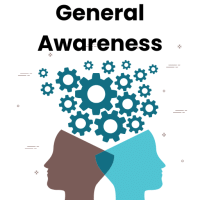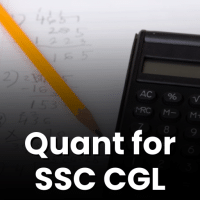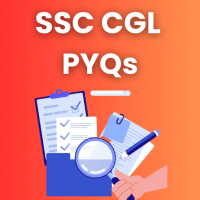SSC CGL Exam > SSC CGL Questions > Direction: In the following information quest...
Start Learning for Free
Direction: In the following information question, the symbols @, ©, %, S and δ are used with the following meaning as illustrated below:
'P % Q' means 'P is greater than Q'
'P δ Q' means 'P is neither greater than smallest than Q'
'P @ Q' means 'P is smallest than Q'.
'p © Q' means 'P is either smallest than or equal to Q'
'P S Q' means 'P is either greater than or equal to Q'
In each of the following questions assuming the given statements to be true, find which of the two conclusions I and II given below them is are definitely true
'P % Q' means 'P is greater than Q'
'P δ Q' means 'P is neither greater than smallest than Q'
'P @ Q' means 'P is smallest than Q'.
'p © Q' means 'P is either smallest than or equal to Q'
'P S Q' means 'P is either greater than or equal to Q'
In each of the following questions assuming the given statements to be true, find which of the two conclusions I and II given below them is are definitely true
Statement :
W © D, D S B, B @ H
Conclusion :
I. H % D II. W @ B
W © D, D S B, B @ H
Conclusion :
I. H % D II. W @ B
- a)if only conclusion I is true
- b)if only conclusion II is true
- c)if either conclusion I or conclusion II is true
- d)if neither conclusion I nor conclusion II is true
Correct answer is option 'D'. Can you explain this answer?
Most Upvoted Answer
Direction: In the following information question, the symbols @, ©...
W ≤ D ....(i) D ≥ B .....(ii) B > H ... (iii)
H and D can't be compared from (ii) and (iii)
Hence; I does not follows
Nor can W and B he be compared From (i) and (ii).
Hence II does not follows
H and D can't be compared from (ii) and (iii)
Hence; I does not follows
Nor can W and B he be compared From (i) and (ii).
Hence II does not follows

|
Explore Courses for SSC CGL exam
|

|
Question Description
Direction: In the following information question, the symbols @, ©, %, S and δ are used with the following meaning as illustrated below:P % Q means P is greater than QP δ Q means P is neither greater than smallest than QP @ Q means P is smallest than Q.p © Q means P is either smallest than or equal to QP S Q means P is either greater than or equal to QIn each of the following questions assuming the given statements to be true, find which of the two conclusions I and II given below them is are definitely trueStatement :W © D, D S B, B @ HConclusion :I. H % D II. W @ Ba)if only conclusion I is trueb)if only conclusion II is truec)if either conclusion I or conclusion II is trued)if neither conclusion I nor conclusion II is trueCorrect answer is option 'D'. Can you explain this answer? for SSC CGL 2025 is part of SSC CGL preparation. The Question and answers have been prepared according to the SSC CGL exam syllabus. Information about Direction: In the following information question, the symbols @, ©, %, S and δ are used with the following meaning as illustrated below:P % Q means P is greater than QP δ Q means P is neither greater than smallest than QP @ Q means P is smallest than Q.p © Q means P is either smallest than or equal to QP S Q means P is either greater than or equal to QIn each of the following questions assuming the given statements to be true, find which of the two conclusions I and II given below them is are definitely trueStatement :W © D, D S B, B @ HConclusion :I. H % D II. W @ Ba)if only conclusion I is trueb)if only conclusion II is truec)if either conclusion I or conclusion II is trued)if neither conclusion I nor conclusion II is trueCorrect answer is option 'D'. Can you explain this answer? covers all topics & solutions for SSC CGL 2025 Exam. Find important definitions, questions, meanings, examples, exercises and tests below for Direction: In the following information question, the symbols @, ©, %, S and δ are used with the following meaning as illustrated below:P % Q means P is greater than QP δ Q means P is neither greater than smallest than QP @ Q means P is smallest than Q.p © Q means P is either smallest than or equal to QP S Q means P is either greater than or equal to QIn each of the following questions assuming the given statements to be true, find which of the two conclusions I and II given below them is are definitely trueStatement :W © D, D S B, B @ HConclusion :I. H % D II. W @ Ba)if only conclusion I is trueb)if only conclusion II is truec)if either conclusion I or conclusion II is trued)if neither conclusion I nor conclusion II is trueCorrect answer is option 'D'. Can you explain this answer?.
Direction: In the following information question, the symbols @, ©, %, S and δ are used with the following meaning as illustrated below:P % Q means P is greater than QP δ Q means P is neither greater than smallest than QP @ Q means P is smallest than Q.p © Q means P is either smallest than or equal to QP S Q means P is either greater than or equal to QIn each of the following questions assuming the given statements to be true, find which of the two conclusions I and II given below them is are definitely trueStatement :W © D, D S B, B @ HConclusion :I. H % D II. W @ Ba)if only conclusion I is trueb)if only conclusion II is truec)if either conclusion I or conclusion II is trued)if neither conclusion I nor conclusion II is trueCorrect answer is option 'D'. Can you explain this answer? for SSC CGL 2025 is part of SSC CGL preparation. The Question and answers have been prepared according to the SSC CGL exam syllabus. Information about Direction: In the following information question, the symbols @, ©, %, S and δ are used with the following meaning as illustrated below:P % Q means P is greater than QP δ Q means P is neither greater than smallest than QP @ Q means P is smallest than Q.p © Q means P is either smallest than or equal to QP S Q means P is either greater than or equal to QIn each of the following questions assuming the given statements to be true, find which of the two conclusions I and II given below them is are definitely trueStatement :W © D, D S B, B @ HConclusion :I. H % D II. W @ Ba)if only conclusion I is trueb)if only conclusion II is truec)if either conclusion I or conclusion II is trued)if neither conclusion I nor conclusion II is trueCorrect answer is option 'D'. Can you explain this answer? covers all topics & solutions for SSC CGL 2025 Exam. Find important definitions, questions, meanings, examples, exercises and tests below for Direction: In the following information question, the symbols @, ©, %, S and δ are used with the following meaning as illustrated below:P % Q means P is greater than QP δ Q means P is neither greater than smallest than QP @ Q means P is smallest than Q.p © Q means P is either smallest than or equal to QP S Q means P is either greater than or equal to QIn each of the following questions assuming the given statements to be true, find which of the two conclusions I and II given below them is are definitely trueStatement :W © D, D S B, B @ HConclusion :I. H % D II. W @ Ba)if only conclusion I is trueb)if only conclusion II is truec)if either conclusion I or conclusion II is trued)if neither conclusion I nor conclusion II is trueCorrect answer is option 'D'. Can you explain this answer?.
Solutions for Direction: In the following information question, the symbols @, ©, %, S and δ are used with the following meaning as illustrated below:P % Q means P is greater than QP δ Q means P is neither greater than smallest than QP @ Q means P is smallest than Q.p © Q means P is either smallest than or equal to QP S Q means P is either greater than or equal to QIn each of the following questions assuming the given statements to be true, find which of the two conclusions I and II given below them is are definitely trueStatement :W © D, D S B, B @ HConclusion :I. H % D II. W @ Ba)if only conclusion I is trueb)if only conclusion II is truec)if either conclusion I or conclusion II is trued)if neither conclusion I nor conclusion II is trueCorrect answer is option 'D'. Can you explain this answer? in English & in Hindi are available as part of our courses for SSC CGL.
Download more important topics, notes, lectures and mock test series for SSC CGL Exam by signing up for free.
Here you can find the meaning of Direction: In the following information question, the symbols @, ©, %, S and δ are used with the following meaning as illustrated below:P % Q means P is greater than QP δ Q means P is neither greater than smallest than QP @ Q means P is smallest than Q.p © Q means P is either smallest than or equal to QP S Q means P is either greater than or equal to QIn each of the following questions assuming the given statements to be true, find which of the two conclusions I and II given below them is are definitely trueStatement :W © D, D S B, B @ HConclusion :I. H % D II. W @ Ba)if only conclusion I is trueb)if only conclusion II is truec)if either conclusion I or conclusion II is trued)if neither conclusion I nor conclusion II is trueCorrect answer is option 'D'. Can you explain this answer? defined & explained in the simplest way possible. Besides giving the explanation of
Direction: In the following information question, the symbols @, ©, %, S and δ are used with the following meaning as illustrated below:P % Q means P is greater than QP δ Q means P is neither greater than smallest than QP @ Q means P is smallest than Q.p © Q means P is either smallest than or equal to QP S Q means P is either greater than or equal to QIn each of the following questions assuming the given statements to be true, find which of the two conclusions I and II given below them is are definitely trueStatement :W © D, D S B, B @ HConclusion :I. H % D II. W @ Ba)if only conclusion I is trueb)if only conclusion II is truec)if either conclusion I or conclusion II is trued)if neither conclusion I nor conclusion II is trueCorrect answer is option 'D'. Can you explain this answer?, a detailed solution for Direction: In the following information question, the symbols @, ©, %, S and δ are used with the following meaning as illustrated below:P % Q means P is greater than QP δ Q means P is neither greater than smallest than QP @ Q means P is smallest than Q.p © Q means P is either smallest than or equal to QP S Q means P is either greater than or equal to QIn each of the following questions assuming the given statements to be true, find which of the two conclusions I and II given below them is are definitely trueStatement :W © D, D S B, B @ HConclusion :I. H % D II. W @ Ba)if only conclusion I is trueb)if only conclusion II is truec)if either conclusion I or conclusion II is trued)if neither conclusion I nor conclusion II is trueCorrect answer is option 'D'. Can you explain this answer? has been provided alongside types of Direction: In the following information question, the symbols @, ©, %, S and δ are used with the following meaning as illustrated below:P % Q means P is greater than QP δ Q means P is neither greater than smallest than QP @ Q means P is smallest than Q.p © Q means P is either smallest than or equal to QP S Q means P is either greater than or equal to QIn each of the following questions assuming the given statements to be true, find which of the two conclusions I and II given below them is are definitely trueStatement :W © D, D S B, B @ HConclusion :I. H % D II. W @ Ba)if only conclusion I is trueb)if only conclusion II is truec)if either conclusion I or conclusion II is trued)if neither conclusion I nor conclusion II is trueCorrect answer is option 'D'. Can you explain this answer? theory, EduRev gives you an
ample number of questions to practice Direction: In the following information question, the symbols @, ©, %, S and δ are used with the following meaning as illustrated below:P % Q means P is greater than QP δ Q means P is neither greater than smallest than QP @ Q means P is smallest than Q.p © Q means P is either smallest than or equal to QP S Q means P is either greater than or equal to QIn each of the following questions assuming the given statements to be true, find which of the two conclusions I and II given below them is are definitely trueStatement :W © D, D S B, B @ HConclusion :I. H % D II. W @ Ba)if only conclusion I is trueb)if only conclusion II is truec)if either conclusion I or conclusion II is trued)if neither conclusion I nor conclusion II is trueCorrect answer is option 'D'. Can you explain this answer? tests, examples and also practice SSC CGL tests.

|
Explore Courses for SSC CGL exam
|

|
Signup for Free!
Signup to see your scores go up within 7 days! Learn & Practice with 1000+ FREE Notes, Videos & Tests.


















